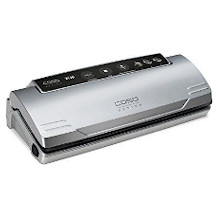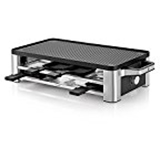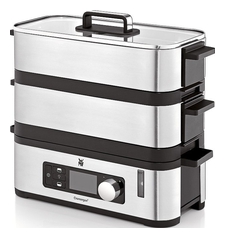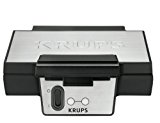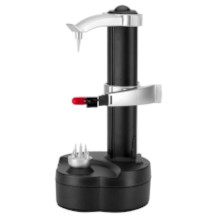Microwave purchasing advice: how to choose the right product
- What you need to know
- Microwaves are useful kitchen gadgets for defrosting and quickly heating food and drink. Some models have additional features for cooking, grilling, and baking.
- Microwaves are much faster and more energy efficient than ovens. They also take up much less space – great for small flats.
- Most microwaves use full power to cook and then take breaks at certain intervals to make sure the food doesn’t burn – modern inverter microwaves can adjust their power precisely.
- The most important things to consider when buying a microwave are its features, capacity, power, ease of use, and dimensions.
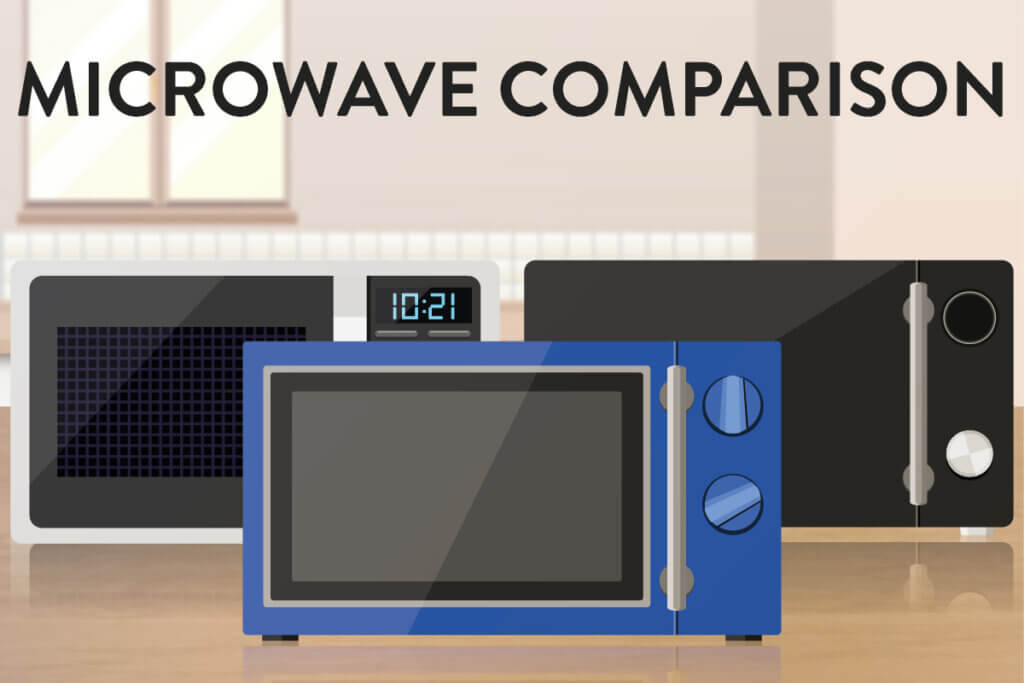
How microwaves work
Just like toasters and kettles, microwaves are a common sight in kitchens. So much so in fact, that in both the UK and the USA, over 90% of households own one, and many office pantries have microwaves too. Microwaves make preparing food very fast and easy – perfect for our busy lives.
Heating water molecules
Microwaves are well known as useful kitchen machines for quickly warming up food. What is less known is how they actually work. Compared to conventional ovens, microwave ovens don’t cook with heating elements. As their name suggests, microwaves work using low frequency electromagnetic waves. These waves transfer their energy into kinetic energy in the water molecules in food. As a result, they increase the water molecules’ temperature to heat up food.
Microwave preconceptions
The technology which makes microwaves work is not met with universal enthusiasm. There is still widespread fear surrounding the danger of radiation potentially escaping from microwaves, and of electromagnetic waves affecting food and leading to long term health problems.
Microwaves and the human body
Microwaves agitate water molecules and as a result heat them. This doesn’t just happen with food, it can also happen with the human body. The fear surrounding electromagnetic waves is thus not ungrounded – they are biologically dangerous. However, the microwaves on the market today are well insulated.
Undamaged devices only emit a very small amount of radiation into their surroundings. Microwave ovens are subject to strict regulatory testing to make sure this amount is not too high. The limit set for microwaves that can leak out is 5 milliwatts (mW) per square centimeter, five centimeters from the oven. This amount is far below what is dangerous to humans, and tests have never shown this limit to have been exceeded.
Do microwaves change food?
Multiple studies have shown that when used correctly, microwaves do not affect the content of the food they heat up. As with heating on a stovetop, the important thing is to cook the food gently so as not to lose all of its nutrients. There are also no residual microwaves remaining in the food after heating.
Which foods aren’t microwave-safe?
It’s best to avoid preparing baby food and things like eggs and poultry. Microwaves don’t always heat food up completely evenly, which can be potentially dangerous as bacteria like salmonella and listeria won’t be totally killed.
Quick, energy efficient, and versatile
Microwaves are great for heating up small portions, especially leftovers. They are much faster and more efficient for this than ovens or stovetops. Unlike ovens, there’s no need to preheat microwaves. A further positive is that they are much more compact than ovens, which is great for small kitchens.
Microwaves are very useful for thawing frozen food. You can defrost things in a matter of minutes. Some modern microwaves also have grill and baking functionality too, which can make having a normal oven practically redundant. Some models can also cook with steam. These microwaves are designed to heat food in a way which preserves most of the vitamins and nutrients.
Advantages of a microwave
- More energy efficient than ovens
- Space-saving
- Quickly heat small portions
- Gently thaw frozen food
- Some models also have baking and grilling features
What to look out for before buying
There are a lot of different microwaves on the market. Read on for the most important things to consider when making a purchase decision.
Capacity
Sometimes referred to as the cooking volume, microwave capacity is one of the most important things to consider when choosing a model. Most microwaves have a capacity between 15 and 30 liters. The size you’ll need of course depends on what you’ll be making and how big your portions are. Microwaves with a capacity of up to 20 liters are generally best for singles or couples. If you’re wanting a microwave with baking or grilling as an oven replacement, then go for a capacity of more than 20 liters so you can make things like pizzas. The same can be said for households of more than three people who plan on heating up food at the same time.
There are also larger models on the market with cooking volumes of up to 50 liters. These are generally best suited for professional kitchens. A microwave of this size will usually be overkill for home use.
Dimensions
Microwave dimensions vary depending on their capacity. The following table gives a general overview of the range of dimensions on the market:
| Minimum | Maximum | |
| Width | 37cm (14.6″) | 60cm (23.6″) |
| Height | 22cm (8.6″) | 57cm (22.4″) |
| Depth | 26cm (10.2″) | 57cm (22.4″) |
Whatever size model you end up going for, make sure you have plenty of space for air to circulate around the microwave. It’s best to have at least a 3.9-inch (10cm) gap between each side and the back wall, and 7.9 inches (20cm) above.
Power
Each microwave model has a power output capacity, measured in watts (W). As a rule of thumb, the more features and the larger the cooking volume, the higher the power output needed – otherwise cooking times become too long. For small, entry-level microwaves, a power capacity of between 700 and 800W is enough. Microwaves with a larger cooking volume (more than 20 liters) and extra features like defrosting, grilling, and steam cooking will need a power capacity of 1400W or more. The main thing to note is that these faster microwaves with more power will of course use more energy – it’s up to you to decide whether cooking speed or saving on electricity are more important.
Another thing to look out for is a microwave with adjustable power levels so you can defrost delicate things like fish with a lower wattage. In this regard, microwaves with inverter technology are especially good as they can adjust their power output – without this the microwave will intermittently heat at full power instead.
Controls
Using a microwave should be as intuitive and easy as possible. There are two main types of controls you’ll find on the market:

Mechanical controls
These mechanical dials are most common on simpler and more basic microwaves. On most models there are two variables to control: the cooking time, and the power. Cooking time can be set in 10 second intervals or in minutes.

Digital controls
Digital controls offer a more specific, wider range of settings. Microwaves with lots of different features have these kinds of controls. Most models will have buttons and an LC-display to select different settings or cooking programs. These controls are more complex and harder to use, but they offer more possibilities.
Ease of use
On some microwaves the dials or buttons are retractable, which makes cleaning easier. You can also save settings and heating programs on some digital models. Another useful feature to look out for is a programmable timer which makes it possible to set a specific time for the microwave to turn on. As an example, you might put your dinner in the microwave before going to work in the morning, and with the help of the timer, you can return home to a meal that is already hot. You can also use the different microwave features in series. For example, you can program a microwave to first heat your food and then brown it if it has a grill.
Casing material
The inside of a microwave is always made of metal in order to keep the electromagnetic waves inside. The outer casing on the other hand is most frequently one of three materials:
- Plastic
- Glass
- Stainless steel
The cheapest models are usually made with plastic, which is light and easy to clean. Microwaves with plastic housings are generally less long lasting than those with steel cases since they discolor faster. On the other hand, plastic cases are less susceptible to fingerprint marks.
More expensive microwaves ($120 or more) generally have steel cases with glass fronts which look premium and modern. Aside from styling, steel and glass are more durable and less prone to discoloration than plastic. They will, however, demand a little more wiping and polishing because they are more susceptible to fingerprint marks. This said, some high-end models have a special coating on the stainless steel which reduces fingerprint marks.
What can a microwave do?
Not only do microwave models vary based on their build materials, but they also have different features. Cheaper microwaves ($60-120) generally have just the basics, but once you enter the higher price brackets there are a diverse range of additional features available.
The basics: variable power in intervals
Fundamental to any microwave is the ability to heat food using different power levels – normally around five or six. The most common way this happens is with intervals. Microwaves always operate using full power, the amount of which depends on the output capacity of the machine. When a lower power level is selected, the actual power output doesn’t decrease. Instead, the microwave will emit the electromagnetic waves in intervals with pauses in between. For example, if you were to set an 800W microwave to work at 400W, the machine would heat the food for say five seconds, and then pause for five seconds before repeating.
The exception: inverter microwaves
High-end modern microwaves ($170 or more) generally don’t use intervals to decrease their power output. Instead, they use inverter technology. This involves using a special switching power supply to decrease the wattage output. The benefit of this is that you can defrost and cook much more delicate foods in the microwave, like fish. Another positive is that the heating is much more even, and the energy efficiency is better.
Advantages
- Gentler defrosting and cooking
- Very energy efficient
- Consistent heating
Disadvantages
- Expensive
Other useful features
High-end microwaves often have useful extra features to prepare specific foods.

Thawing
All microwaves can defrost frozen food on a low power setting. If you set the wattage to between 180 and 240W, the food won’t get cooked or lose nutrients. What is easier and safer, however, is when certain microwave models have a specific thawing pre-program. Using the weight of the frozen food, the microwave will automatically calculate the time and power it needs to defrost it.

Convection and conduction
Cooking food with circulating hot air long seemed only the preserve of the oven, but now some modern microwaves also have convection as a feature, making them like small ovens themselves. Hot air gets blown around in both convection and conduction ovens, cooking the food evenly and browning it. For this to happen, the air has to be at least 200°C. In order to do this, microwaves work by combining electromagnetic waves with conventional oven heating elements and fans. These combination microwaves make it possible to bake pizza, bread, or casseroles.
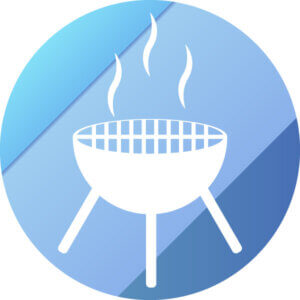
Grilling
If you want food that is not only warm but is also crispy and roasted, then go for a microwave with a grill function. Some of the devices on the market cost as little as $120. The integrated grills are either quartz or infra-red. In combination with a rotating plate, a quartz grill is great for evenly browning food like macaroni and cheese. While quartz grills are located on the ceiling of the cooking chamber, infra-red grills radiate from all sides. The evenness you can get from this makes them great for cooking foods like chicken that need to be cooked evenly.

Steaming
Steaming allows you to gently cook food with water vapor. The inside structure and the outside appearance of the food are unaffected with this kind of cooking. Moreover, vitamins, nutrients, and aromas are preserved. Microwave ovens with steam functionality work using a water tank. To steam the food, the microwave heats the water to turn it into steam. Depending on the model, you can steam food at between 30 and 100 °C.

Keeping food warm
Alongside their food preparation features, some microwaves have a program to keep cooked food warm. This feature holds the temperature of the food and doesn’t cook it any further to prevent dry or burnt dinner. Normally, this feature will automatically activate if the microwave door stays shut after cooking. Depending on the model, food can be kept warm for 15 to 90 minutes.

Self-cleaning
Self-cleaning is an extremely helpful feature of mostly premium microwaves. Say goodbye to the irksome and tiring task of regular cleaning. Self-cleaning microwaves work using steam which circulates inside the cooking chamber for 10-15 minutes. The water either comes from an integrated tank (the same as for steam cooking) or from a container that you need to put in the center of the chamber. The steam gets rid of all the dirt on the walls, and all you have to do is give the inside of the microwave a quick wipe.
Types of microwave
There are lots of different design variations when it comes to microwaves. Broadly speaking, you can split the market up by thinking about the way in which a microwave is installed. The different designs which determine how the electromagnetic waves are distributed inside the cooking chamber are another set of factors to consider when looking at the range of microwaves available. There are three distinct categories when it comes to microwave installation:

Freestanding
The most commonly owned microwaves are freestanding – the only installation they need is to be plugged in to a mains socket. When choosing where to put one of these microwaves, it is best to leave at least 3.9 inches (10cm) around it for air to circulate. The flexibility that comes with a freestanding microwave is a big advantage, as is the ability to easily replace it if it breaks.

Integrated
In contrast to freestanding microwaves, integrated models don’t take up any space on kitchen work surfaces. The flipside to this is that you lose a certain amount of flexibility. An integrated microwave requires a degree of pre-planning, and it is also not so easy to swap out. In most cases, it’s best to get a professional to do any installation or replacement work. This being said, an integrated microwave blends harmoniously into a kitchen. It is really best option if you’re planning a new kitchen renovation.

Built-in
The compromise between freestanding and integrated microwaves comes in the form of the so-called “built-in” or “low profile” variety. These microwaves are mounted underneath a kitchen cupboard. In order to do this, they have at least four holes on their topside so that they can be screwed in. The advantage of this is that you don’t need to plan as far in advance as with an integrated microwave, but nor do you lose the space like you would with a freestanding machine. This said, they aren’t as slick as their fully integrated counterparts nor as totally flexible as their freestanding ones either. When installing your built-in microwave, the main things to check are whether the mounting cupboard can hold the weight, if there is a plug socket nearby, and if there will be enough air circulation. Built-in microwaves are great for people who don’t have enough countertop space and don’t have anywhere to put an integrated model.
Wave distribution architecture
Alongside the differences in how microwaves are installed, you can also differentiate between models depending on how their design affects the distribution of electromagnetic waves inside the cooking chamber. The most important thing is for the waves to be consistently distributed, so that the food and drinks become evenly heated.

Turntable
Turntables are the classic and most common wave distribution design. The basic idea is that a plate sits loosely on a motor in the center of the cooking chamber floor. You put the food in a microwave-safe container on the plate which then rotates so that heat is evenly distributed.

Stirring reflector
In comparison to turntables, wave stirring reflectors or fans are mounted on the topside of the cooking chamber. They spin during heating, reflecting the microwaves bouncing around the chamber so that they are evenly distributed.

Stirring antenna
Stirring antennas work in a similar way to stirring fans. They can be either in the roof of the cooking chamber, or in the floor. Like the fans, they rotate to evenly distribute microwaves in the chamber.

Reflecting point
Another way in which microwaves get distributed within the cooking chamber is through a reflecting point. This is opposite to where the waveguide sends the microwaves to first get radiated into the cooking chamber, so it can reflect and distribute them.
Distribution designs combined
As the idiom goes, two heads are better than one. Many microwave ovens combine wave distribution designs for better performance. Some models, known as flatbed microwaves, even incorporate stirrers to do away with needing a turntable. These microwaves benefit from having an especially large cooking chamber so you can heat up bigger plates of food.
Safe use
Microwaves aren’t a complete panacea – these practical machines do have dangers which can surface when not used correctly. This potential of course plays into the preconceptions surrounding microwaves and safety. However, it is important to reiterate that there are no dangers when using a standard, intact microwave properly. To avoid any problems, make sure to read and follow the manual and safety information that comes with your microwave.
Safety tips
Just like other kitchen machines and gadgets, microwaves are often fitted with some extra safety features. These include:

Automatic power off
To prevent the microwaves from escaping the microwave oven itself, most devices automatically turn off when the door is open. To prevent potential fires, microwaves are also fitted with thermometers which can turn the machine off if the temperature is too high.

Child lock
If you have children in your household, you should make sure that you choose a microwave which has a child lock to prevent kids from turning on or changing the machine’s settings unsupervised. Most child locks function using the control panel – in most models unlocking the microwave will work using a code or by pressing a button in a certain way.
Using the right containers
Not all materials are microwave safe. To prevent any accidents, make sure to always use the right kind of containers inside your microwave. The following materials are completely fine to use:
- Glass
- Porcelain
- Microwave-safe plastics
Metals, sealed containers, and plastics that aren’t microwave safe should not be used. Metal containers will deflect the microwaves, meaning that you won’t be able to warm your food up. In the worst cases, metal can cause sparks and electric arcs which can destroy the microwave.
Test your dishes
If you’re not sure about using a particular container inside your microwave, there’s an easy test you can do to find out if it’s safe. Just put the empty container in the microwave for 30 seconds on full power. If the container hasn’t heated up, it’s completely fine to use. When you do this test, put a glass of water in the microwave too – you should never turn a microwave on without anything inside.
Cleaning and defrosting
It’s important to regularly clean your microwave. Read on for cleaning tips, but first let’s look at how to defrost different foods.
Defrosting
Microwaves are great for quickly defrosting food. The main things you need to know to do this safely are as follows:
- Use a low power setting (around 180W) or a pre-set defrost program
- Put the frozen food in an open, microwave-safe container
- Move the food around while it is defrosting in the microwave so that it thaws evenly
- When defrosting meat and fish, get rid of the liquid that runs off
- After defrosting in the microwave, let the food rest at room temperature for 10 to 15 minutes
The time it takes for food to defrost depends on power, quantity, and food type. The following table gives some rough examples of timings when defrosting with 180W power:
| Food | Quantity | Duration |
| Bread rolls | 4 pieces | 2–5 min |
| Bread | 2.2 lb (1kg) | 15 min |
| Fruit | 0.55 lb (250g) | 5 min |
| Vegetables | 0.55 lb 250g | 8 min |
| Cake | 1 piece (~150g) | 3–5 min |
| Fish | 1.1 lb (500g) | 8–10 min |
| Meat | 1.1 lb 500g | 10–15 min |
Cleaning tips
Cleaning the outside of a microwave is best with a cloth or a sponge – dampened if there are a lot of fingerprint marks. Use scouring cream if you’ve got some particularly stubborn dirt and glass cleaner for the door.
More important than cleaning the outside of the microwave is maintaining hygiene inside the cooking chamber as bits of food and squirts of sauce quickly collect in there.
Some models are self-cleaning – a great but usually costly feature. However, if your microwave doesn’t have this functionality, there is a simple trick to help with the cleaning. If you put a container filled with water and lemon or vinegar inside your microwave on full power for ten minutes, you’ll achieve the same effect as the automatic self-cleaning models. The steam will dislodge any mess inside, and you’ll be able to easily wipe your cooking chamber clean.
Images 1-18: © FinalCheck



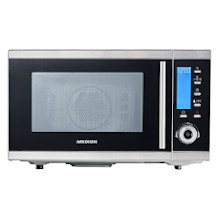
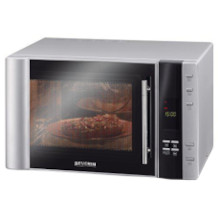
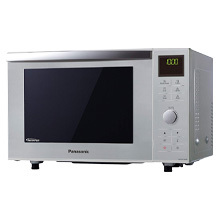
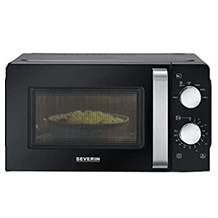
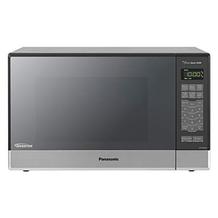
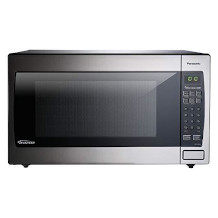
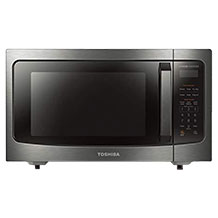
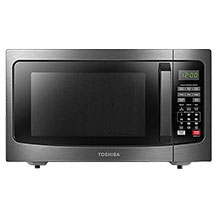
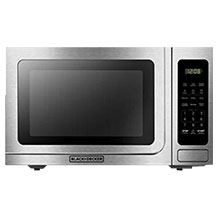
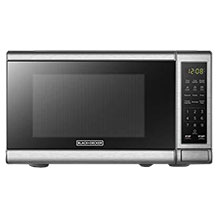
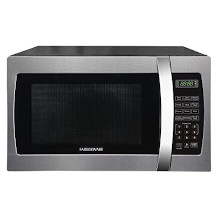
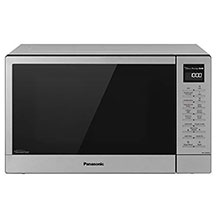

 452 reviews
452 reviews
